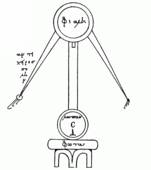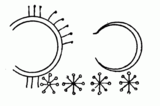
In alchemy, the term chrysopoeia (from Ancient Greek χρυσοποιία (khrusopoiía) 'gold-making') refers to the artificial production of gold, most commonly by the alleged transmutation of base metals such as lead. A related term is argyropoeia (from Ancient Greek ἀργυροποιία (arguropoiía) 'silver-making'), referring to the artificial production of silver, often by transmuting copper. Although alchemists pursued many different goals, the making of gold and silver remained one of the defining ambitions of alchemy throughout its history, from Zosimus of Panopolis (c. 300) to Robert Boyle (1627–1691).[1]
The word was used in the title of a brief alchemical work, the Chrysopoeia of Cleopatra attributed to Cleopatra the Alchemist, which was probably written in the first centuries of the Christian era, but which is first found on a single leaf in a tenth-to-eleventh century manuscript in the Biblioteca Marciana, Venice, MS Marciana gr. Z. 299.[2] The document features an ouroboros containing the words "the all is one" (ἕν τὸ πᾶν, hen to pān), a concept that is related to Hermeticism. Stephen of Alexandria wrote a work called De Chrysopoeia.[3] Chrysopoeia is also the title of a 1515 poem by Giovanni Augurello.
Other images from the Chrysopoeia of Cleopatra[edit]
See also[edit]
References[edit]
- ^ Principe 2013, pp. 13, 170.
- ^ Berthelot 1887, p. 128.
- ^ Linden 2003, p. 54.
Works Cited
- Berthelot, Marcellin (1887). Collection des ancien alchimistes grec. Tome 1. Paris: Steinheil.
- Linden, Stanton J. (2003). The alchemy reader: From Hermes Trismegistus to Isaac Newton.
- Principe, Lawrence M. (2013). The Secrets of Alchemy. Chicago: The University of Chicago Press. ISBN 978-0226103792.


